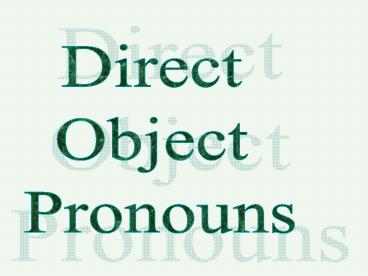Direct - PowerPoint PPT Presentation
1 / 17
Title:
Direct
Description:
OK, before we get into direct object pronouns, let's take a look at something ... Os miro? S , . . . S , nos miras. D nde compras el reloj? Lo compro en Wal-mart. ... – PowerPoint PPT presentation
Number of Views:22
Avg rating:3.0/5.0
Title: Direct
1
Direct Object Pronouns
2
Direct Object Pronouns
- A direct object answers the question what?
or whom? - John saw the book.
- John saw what? John saw the book.
- John saw Mary.
- John saw whom? John saw Mary.
3
- OK, before we get into direct object pronouns,
lets take a look at something Spanish does that
English doesnt with direct object nouns - Veo la flor.
- Veo a Juan.
- Veo el libro.
- Veo a mi amiga.
- Notice how theres an a in two of the sentences
but not in the other two? Can you guess why? - The answer is that whenever the direct object
noun is a PERSON, you put a in front of it.
Thats called a personal a. You DONT put it
in front of the direct object noun if it isnt a
person. - Leo el libro. Veo a Elisa.
- Estudio historia Ayudo a mi novio.
- Hablo español. Necesito a la profesora.
- Now on to direct object pronouns . . .
4
- A pronoun takes the place of a noun
- John saw the book.
- John saw it.
- John and Tim saw Mary.
- John and Tim saw her.
- It and her are direct object pronouns,
because they replace direct objects. Subject
pronouns replace subjects - John saw the book.
- He saw the book.
- John and Tim saw Mary.
- They saw Mary.
- He and they are subject pronouns, because
they replace subjects.
5
- Spanish pronouns look different from English
pronouns, of course, but work exactly the same
way. - Subject Pronouns Direct Object Pronouns
- I we me us
- you yall you yall
- he, she, it they him, her, it them
- yo nosotros me nos
- tú vosotros te os
- él, ella, Ud. ellos, Uds. lo, la los,
las
6
- The one trick to remember is that in Spanish
direct object pronouns come BEFORE the verb. - John reads . John reads .
- BUT Juan lee . Juan lee.
- John reads . John reads
. - BUT Juan lee . Juan
lee. - John reads the letter. John reads it.
- Juan lee la carta. Juan lee.
- John reads the letters. John reads them.
- Juan lee las cartas. Juan las lee.
- Libro is masculine singular, so you replace it
with a masculine singular pronoun lo carta
is feminine singular, so you replace it with a
feminine singular pronoun la etc.
the book
it
it
el libro
lo
lo
the books
them
them
los libros
los
los
la
7
- If you have an infinitive or a present
participle, you can attach the pronoun to the end
of it, but you dont have to - Juan quiere leer el libro. Juan lo quiere
leer. - OR
- Juan quiere leerlo.
- Juan está leyendo el libro. Juan lo está
leyendo. - OR
- Juan está leyéndolo.
- What you CANT do is put the pronoun between the
two verbs.
8
- Examples of sentences with direct object
pronouns - Juan me necesita. Juan needs me.
- Juan te necesita. Juan needs you.
- Juan lo necesita. Juan needs him (or it).
- Juan la necesita. Juan needs her (or it).
- Juan nos necesita. Juan needs us.
- Juan os necesita. Juan needs yall.
- Juan los necesita. Juan needs them (or yall
Uds.). - Juan las necesita. Juan needs them (or yall
Uds.).
9
I seriously suggest you go through these
carefully, answering them on paper. This is hard
material for 95 of my students, and I wouldnt
put my money on being part of the 5 if I were
you.
Examples and Exercises
10
Roberto
Juan
Quién lleva el abrigo? Elena lo
lleva. Quién lleva los pantalones? Juan
los lleva. Quién lleva la corbata?
Roberto la lleva. Quién lleva la camiseta?
Alberto la lleva.
Elena
Alberto
11
Susana
Elena
Quién compra el vestido? Elena lo
compra. Quién compra la falda? Susana la
compra. Quién compra los zapatos? Alicia
los compra. Quién compra las bolsas?
Juana las compra.
Juana
Alicia
12
Juana
Tú
Alicia
Quién te comprende? Juana . . . Juana
me comprende. Quién te necesita? Alicia .
. . Alicia me necesita. Quién te
escucha? Juan . . . Juan me escucha.
Juan
13
Yo
Susana
Roberto
Quién me comprende? Susana . . .
Susana te comprende. Quién me necesita?
Roberto . . . Roberto te necesita. Quién
me escucha? Teresa . . . Teresa te
escucha.
Teresa
14
Yo
Os escucho? Sí, . . . Sí, nos
escuchas. Os comprendo? Sí, . . . Sí,
nos comprendes. Os miro? Sí, . . .
Sí, nos miras.
Vosotros
15
en la cafetería
ahora
Dónde compras el reloj? Lo compro en
Wal-mart. Cuándo lees los libros? Los leo
ahora. Dónde comes la banana? La como en
la cafetería. Cuándo escribes las cartas?
Las escribo a las tres.
en Wal-mart
a las tres
16
Tú
Alicia
Juana
Quién lleva el abrigo? Elena lo
lleva. Quién te escucha? Juana me
escucha. Quién compra las bolsas? Alicia
las compra. Los comprendo (a Uds.)? Sí,
nos comprendes.
Elena
Yo
Uds.
17
- Click here to go to your homework on direct
object pronouns.































